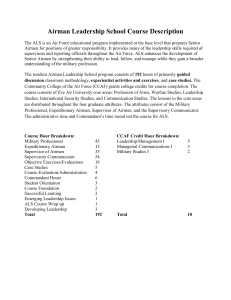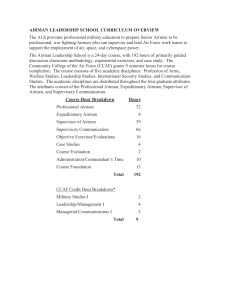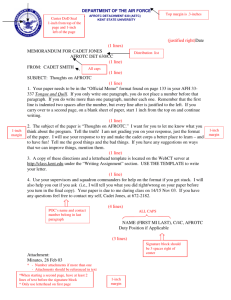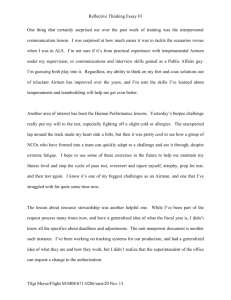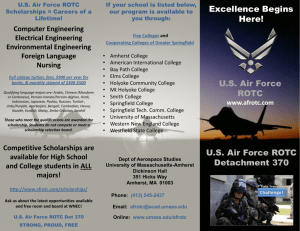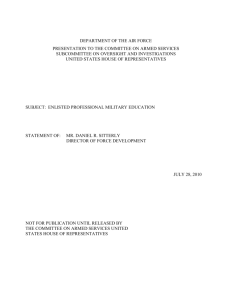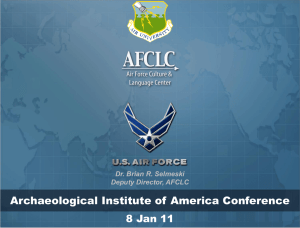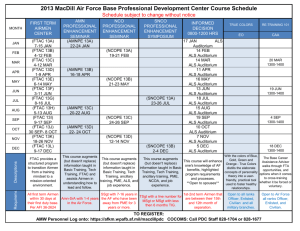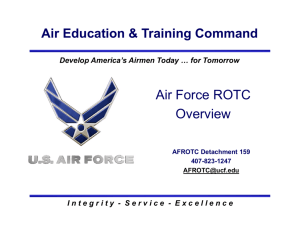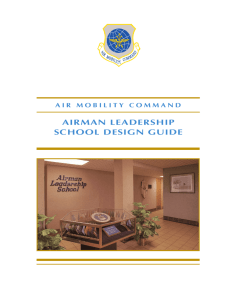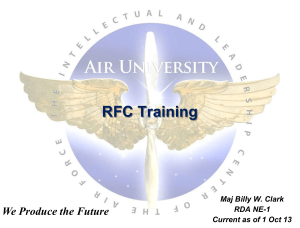CAP6S2LL16.5Handout 1 26-11 AIRMAN LEADERSHIP SCHOOL
advertisement
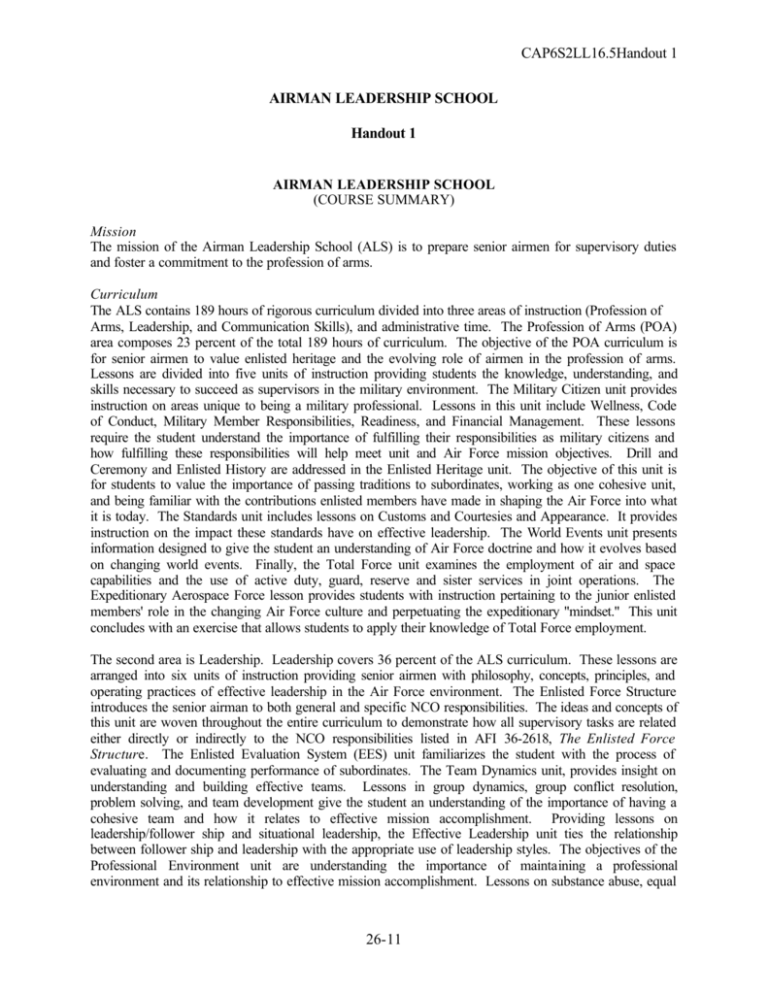
CAP6S2LL16.5Handout 1 AIRMAN LEADERSHIP SCHOOL Handout 1 AIRMAN LEADERSHIP SCHOOL (COURSE SUMMARY) Mission The mission of the Airman Leadership School (ALS) is to prepare senior airmen for supervisory duties and foster a commitment to the profession of arms. Curriculum The ALS contains 189 hours of rigorous curriculum divided into three areas of instruction (Profession of Arms, Leadership, and Communication Skills), and administrative time. The Profession of Arms (POA) area composes 23 percent of the total 189 hours of curriculum. The objective of the POA curriculum is for senior airmen to value enlisted heritage and the evolving role of airmen in the profession of arms. Lessons are divided into five units of instruction providing students the knowledge, understanding, and skills necessary to succeed as supervisors in the military environment. The Military Citizen unit provides instruction on areas unique to being a military professional. Lessons in this unit include Wellness, Code of Conduct, Military Member Responsibilities, Readiness, and Financial Management. These lessons require the student understand the importance of fulfilling their responsibilities as military citizens and how fulfilling these responsibilities will help meet unit and Air Force mission objectives. Drill and Ceremony and Enlisted History are addressed in the Enlisted Heritage unit. The objective of this unit is for students to value the importance of passing traditions to subordinates, working as one cohesive unit, and being familiar with the contributions enlisted members have made in shaping the Air Force into what it is today. The Standards unit includes lessons on Customs and Courtesies and Appearance. It provides instruction on the impact these standards have on effective leadership. The World Events unit presents information designed to give the student an understanding of Air Force doctrine and how it evolves based on changing world events. Finally, the Total Force unit examines the employment of air and space capabilities and the use of active duty, guard, reserve and sister services in joint operations. The Expeditionary Aerospace Force lesson provides students with instruction pertaining to the junior enlisted members' role in the changing Air Force culture and perpetuating the expeditionary "mindset." This unit concludes with an exercise that allows students to apply their knowledge of Total Force employment. The second area is Leadership. Leadership covers 36 percent of the ALS curriculum. These lessons are arranged into six units of instruction providing senior airmen with philosophy, concepts, principles, and operating practices of effective leadership in the Air Force environment. The Enlisted Force Structure introduces the senior airman to both general and specific NCO responsibilities. The ideas and concepts of this unit are woven throughout the entire curriculum to demonstrate how all supervisory tasks are related either directly or indirectly to the NCO responsibilities listed in AFI 36-2618, The Enlisted Force Structure. The Enlisted Evaluation System (EES) unit familiarizes the student with the process of evaluating and documenting performance of subordinates. The Team Dynamics unit, provides insight on understanding and building effective teams. Lessons in group dynamics, group conflict resolution, problem solving, and team development give the student an understanding of the importance of having a cohesive team and how it relates to effective mission accomplishment. Providing lessons on leadership/follower ship and situational leadership, the Effective Leadership unit ties the relationship between follower ship and leadership with the appropriate use of leadership styles. The objectives of the Professional Environment unit are understanding the importance of maintaining a professional environment and its relationship to effective mission accomplishment. Lessons on substance abuse, equal 26-11 CAP6S2LL16.5Handout 1 opportunity and treatment (EOT), professional relationships, diversity, stress and time management, and disciplinary corrective actions are examined. The final unit in the Leadership area is Human Resource Development. This unit focuses on the importance of evaluation and includes lessons on evaluation and reporting, mentoring, and counseling. The goal of this unit is to have senior airmen understand the importance of properly developing, evaluating, and documenting subordinate performance. The Communication Skills area covers 24 percent of the total 189 hours of curriculum. Communication Skills is divided into five units of instruction concentrated on developing effective writing and speaking skills. The Writing Diagnostics unit is designed to provide feedback regarding the student's writing abilities to both the student and the instructor. The Writing Skills unit enhances writing skills by providing instruction in the areas of organization, support and development of bullet statements. Lessons include Preparing for Communication, Effective Writing, Basic Grammar, and Bullet Statements. The Speaking Skills unit provides students the opportunity enhance speaking skills by demonstrating the principles of organization, support, and delivery. The goals of the Interpersonal Communication unit are effective communication and effective listening. The final unit, Evaluating Communication, provides students the method used during the course to evaluate individual writing and speaking assignments. Methodologies The ALS uses many techniques to help students reach the knowledge and comprehension levels of learning. Students engage in informal lectures in auditorium settings, while guided discussions in the classroom with 12 to 15 students provide students the opportunity to discuss, explore, and share experiences on given curriculum topics. Additionally, small group exercises and case studies are used in the experiential learning process. Students also learn from each other through the communication skills speaking projects and in small, student-led study groups. Lesson preparation on the part of each student is required prior to many of the lessons. Evaluation To ensure course objectives are met, students must pass challenging evaluations. These range from affective survey instruments and performance evaluations to objective phase tests. Eligible Population The ALS is open to senior airmen with 48 months time in service and one-year retainability. Completion of ALS is required before assuming the rank of staff sergeant. GLOSSARY OF TERMS: Area: General subject content. Unit: Grouping of related subjects. Lesson: Individual subjects related to the unit and area. 26-12 CAP6S2LL16.5Handout 2 ACADEMIC MAJORS Handout 2 TECHNICAL MAJORS Science Architecture Chemistry Computer Science Mathematics Meteorology Physics Aeronautical Engineering Aerospace Engineering Architectural Engineering Chemical Engineering Civil Engineering Computer Engineering Engineering Electrical Engineering Environmental Engineering Industrial Engineering Mechanical Engineering Nuclear Engineering NONTECHNICAL MAJORS General Business Admin/Mgt Accounting Geography Business Admin Management Political Science Economics Psychology Other majors accepted Caribbean Eastern Europe Far East Latin America North Africa Sub-Sahara Africa Arabic Dutch German Japanese Persian Faris Port Brazilian Spanish Turkish Foreign Area Studies Mediterranean Middle East Russia South Asia Southeast Asia Western Europe Foreign Language Chinese Mandarin French Italian Korean Polish Russian Tagalog Vietnamese 26-13 CAP1S2LL16.5Handout 3 FACT SHEET Handout 3 FACT SHEET PILOT AND NAVIGATOR QUALIFICATIONS Air Force ROTC (AFROTC) has a very competitive program for qualified people who desire to become a pilot or navigator. AFROTC helps you pursue a degree while earning a commission as an Air Force officer. It can be your ticket into the special world of flying. AFROTC offers a 4-year and a 2-year program. All Air Force cadets in the Professional Officer Course (last 2 years of college) receive a $200 monthly nontaxable allowance during the school year. To compete for a pilot or navigator allocation you need to: ♦ Be enrolled full-time in a school offering AFROTC and qualify for the program. ♦ Be physically qualified: 1) Vision: • normal color vision for both pilots and navigators; distant vision - pilots, uncorrected to 20/70; navigators, 20/200 but corrected to 20/20 • near vision - pilots, uncorrected to 20/20; navigators, 20/40 but corrected • meet refraction, accommodation and astigmatism requirements. to 20/20 2) Have no history of hay fever, or allergies after age 12. No history of asthma at 3) Meet AF weight and physical conditioning requirements 4) Have standing height of 64 to 77 inches and sitting height of 34 to 40 inches any time ♦ Achieve qualifying scores on the Air Force Officer Qualifying Test ♦ Maintain a minimum 2.0 grade-point average 26-14 CAP1S2LL16.5Handout 3 ♦ Receive a waiver for any civil involvement ♦ Be commissioned prior to reaching 29th birthday AFROTC pilot candidates complete an Enhanced Flight Screening Program. This must be accomplished prior to completing Specialized Undergraduate Pilot Training. The program includes both ground and flight training. The ground training is taught by Air Force personnel and includes basic aerodynamics, aircraft systems and emergency procedures. Categorization normally occurs in your junior year based on a very competitive selection process. Factors considered include military performance, leadership ability, academic performance, and physical fitness. If you are not selected for a pilot or navigator allocation, you are still required to complete your AFROTC training and serve on active duty for a minimum of 4 years. After graduating from college and completing all AFROTC requirements, you'll be commissioned as a second lieutenant in the Air Force. Navigators must serve a minimum of 6 years on active duty after completing training, and pilots 10 years after training. For more details, write HQ AFROTC Cadet Personnel Section, 551 E. Maxwell Blvd., Maxwell AFB AL 36112-6106. Information is subject to change and is current as of October 2000. 26-15
